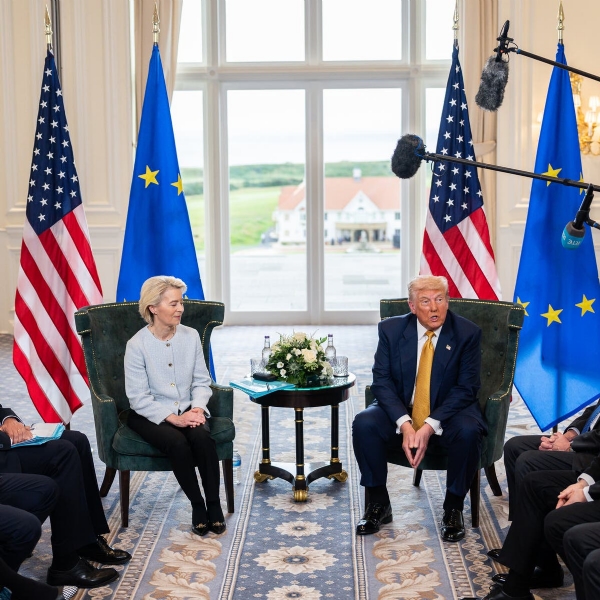
Edinburgh (Scotland), July 28(HS): The European Union and the United States have reached a significant trade agreement, establishing a 15 percent tariff on most E.U. goods, including automobiles and pharmaceuticals, thereby sidestepping a potentially damaging trade war. President Trump announced that the E.U. committed to purchasing $750 billion in American energy over three years. Additionally, the agreement includes investments from the E.U. in the U.S. exceeding $600 billion, with a focus on sectors such as pharmaceuticals and automotive.
The two parties agreed to eliminate tariffs on various goods, including aircraft, plane parts, certain chemicals, select generic drugs, semiconductor equipment, and some agricultural products. While the framework of the agreement offers potential for a more balanced trade relationship, critical details remain unresolved. As Ms. von der Leyen stated, the deal aims to rebalance trade while fostering cooperation.
Despite the progress, not all tariffs were lifted. The 50 percent tariff on steel and aluminum imposed by the Trump administration remains unchanged, although there is a possibility for future negotiations. Moreover, European pharmaceutical and semiconductor exports will be subject to the newly established 15 percent tariffs, regardless of other sector tariffs imposed by the U.S. administration, which is currently investigating additional global tariffs in these industries.
Discussions surrounding the exemption of wine and spirits are still pending, indicating ongoing negotiations. This agreement, though lacking in specific details typical of past preliminary agreements announced by the Trump administration, could stabilize a vital economic relationship and mitigate fears of escalating trade tensions. Last year, the E.U. accounted for nearly $610 billion of the $3.3 trillion in U.S. imports.
The 15 percent tariff rate is aligned with the U.S.-Japanese trade agreement rates, which were recently announced, and is lower than tariffs imposed on several Southeast Asian nations. However, it exceeds the 10 percent tariff European officials sought and is significantly higher than historical U.S. tariffs, reflecting a drastic shift from pre-Trump administration levels of 2.2 percent for the U.S. and 2.7 percent for the E.U.
Concerns remain regarding the clarity of the agreement; many issues still lack resolution. As noted by Mujtaba Rahman from the Eurasia Group, without further exemptions, the deal could fall short of what E.U. member states anticipated. Negotiations leading to this agreement were fraught with unpredictability, especially following a letter from Trump threatening a 30 percent tariff if no resolution was reached by August 1.
Europe was prepared with potential countermeasures in case of failed negotiations, indicating their desire for leverage in talks. The new deal is expected to avert retaliation from the E.U., thereby preventing a trade war that could have had severe economic repercussions on both sides.
The agreement represents a breakthrough in U.S.-E.U. trade negotiations, with both sides acknowledging the imbalance in trade that needed addressing. Specifically, the issue of automotive tariffs was contentious for the E.U., notably for Germany, which had been significantly impacted by the 25 percent tariff on foreign cars imposed by Trump. While the agreement seems to ease some tensions, it raises questions regarding the disparity in tariffs among manufacturers in different regions.
Ultimately, while the new tariff structure is undoubtedly higher than previous rates, von der Leyen emphasized that the 15 percent agreement reflects a significant reduction compared to the potential tariffs that could have emerged without diplomatic efforts.
Hindusthan Samachar / Jun Sarkar





